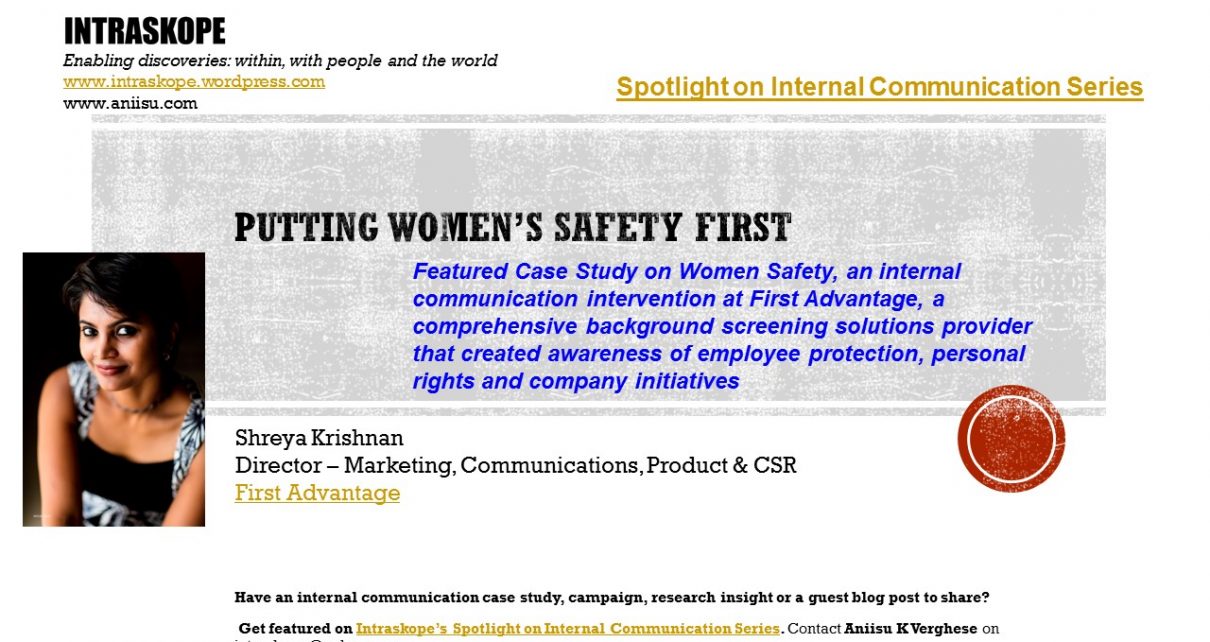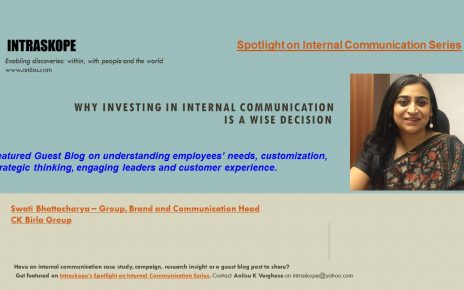In the 4th edition of Intraskope’s Spotlight on Internal Communication Series Shreya Krishnan, Director – Marketing, Communications, Product & CSR at First Advantage shares a campaign on women safety she ran that aligned with government regulations and helped build trust at her organization. Do however, first read her views on internal communication in an interview below.
- What does internal communication mean to you?
Internal communication is only a segment of what I do but it is an important segment of my role. We have two entities – a global operating center and the other, the India specific business. We have a master brand and we localize and modify content to suit our audiences.
Internal communication is unfortunately sometimes underrated, but the power it has to build a fantastic, engaged workforce is something that is gaining traction and understanding. It helps create the energy for the organization and also overcomes crises when they occur. A communicator is crucial at every stage of the business and is relevant at every juncture for each department and its functioning.
- How is it practiced in your organization?
The internal communications function is a key stakeholder across the organization and has a vested interest to be aligned to business and their internal needs. While there are two entities, the order of business for internal communications is similar for both operations. One member of my team manages all internal communication needs. We have a 360° approach for internal communication and use both internal and social tools to interact with our employees and other stakeholders. There is a host of channels we use – intranet, newsletter, posters, emailers, video content, town-halls, fun events, social media, blog, screens, and walls. We conduct employee surveys on communications, track metrics and run training programs and quizzes to validate messages employees receive and assimilate. We take feedback on our events and campaigns periodically. Likewise, focus groups with colleagues are done for campaigns that we are testing and checking impact for.
- Please share a campaign that you are personally proud of working on and that made a significant impact to your organization.
There are several campaigns that we took on in the course of my engagement within the organization. A campaign that I was proud to work on was the social media awareness campaign that we took on after a crisis had struck and we had to employ multiple measures to control the repercussions. This was an instance where an employee had shared content which was inappropriate and it led to media attention. It took the focus away from our business and instead brought negative attention to the brand. We formed a crisis team and a war-room involving HR, compliance and the communications teams. Our leaders were aligned and we created and crafted messages worked on formulating the policy and fixed the damage. The crisis in its wake sensitized us to creating a social media policy for all our employees to be aware. We went on to create a follow-up training and a quiz. The tackling of the crisis and the follow-up has been one of the most challenging yet rewarding campaigns that I have ever worked on.
- What is the biggest challenge you face while going about managing internal communication?
The biggest challenge for us in internal communications has been in getting employees excited about consuming information we share. In a constantly changing technological world, we are often competing with social media updates which employees receive and are faster and more engaging. This challenges internal communication teams to look at content structures, design, appeal, interest levels among other factors to improve experiences of employees. When you have a diverse audience – a combination of millennials and baby boomers you have to continuously innovate and be strategic to add value.
- What according to you is the biggest opportunity that internal communicators have?
Internal communicators have the ability to be heard and to make a difference. They can shape their leaders and communication patterns within organizations. They have a pulse of business and work floors and can be the perfect mediators between the two by creating the right platform and the right mechanisms of cross-organizational communication. Internal communicators are crucial during crisis situations as they hold the reins and ensure the right information is disseminated for the right outcomes. This gives them a huge opportunity to cut noise and create tangible value.
- How can internal communicators add more value to the business?
The internal communication team can leverage relationships and the context of business, leaders, and employees to derive better value. Communications is the backbone of any organization and can make or break businesses. Creating value, driving outcomes and showcasing the return on investing in communications rests with this team. This team can play a remarkable role in policy generation and dissemination, in employer branding, in cross-department communication, employee engagement and stakeholder communication.
- What is your advice for people who are keen to join internal communication and make a career? What skills must they have or develop?
Internal communicators need to have the right blend of creativity, pragmatism, strategic thinking and of course, impeccable written and communication skills. They also need to be excellent at their relationship management and negotiation skills. Having said that, any role – as my former manager used to say, needs just two factors – aptitude and attitude and the rest will follow.
Case Study – Communicating Safety of Women Staffers
In India, 28% of women are in the workforce and about 13% have a regular salaried job. Safety of women is a concern for organizations who conduct business with overseas clients and that expect employees to work night shifts due to the time zone differences. With a spate of incidents that caused concerns for the business community, the government (for example, in Karnataka, a state in South India) instituted guidelines for organizations that employ women employees who work night shifts. Likewise, industry bodies such as Federation of Indian Chambers of Commerce & Industry have also offered recommendations for the safety of women staffers.
At First Advantage, Shreya helped the organization communicate their policy, processes, and steps they were taking to make safety a priority for women employees.
The concern
In the Karnataka Shops and Establishments Act that govern how organizations must conduct themselves with respect to their employees, there are a few conditions that refer to protecting women employees who work before 6 am and after 8 pm at their respective workplaces. As an organization, we wanted to successfully implement these precautionary measures and also educate our women employees about their safety and security rights.
The intervention
The Communication team partnered with the Administration, Human Resource, and Compliance departments to collectively sensitize women employees on safety guidelines and the arrangements we had available for those working night shifts.
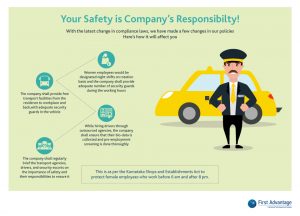

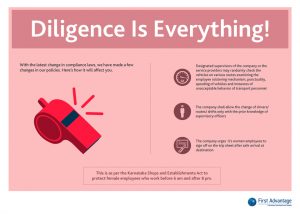
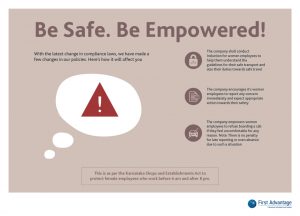
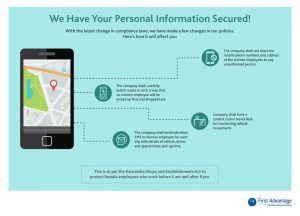
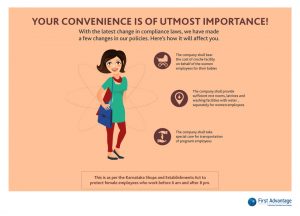
The solution
We ideated and conceptualized the Women Safety campaign, formulated the content creation, designed and circulated messages through creative posters and emailers. We also did role-plays, created self-help brochures and set-up complaint boxes and helpdesks.
The impact
Through this campaign, we successfully overcome the concerns that many shift employees had – a great deal of skepticism about working at night. Due to our intervention, we noticed an increase in awareness about the safety arrangements we made for them. Consistent communication also resulted in a decrease in the number of women safety cases being reported too.
The change
With the help of a background verification company, we ensured that we employed thoroughly verified personnel in transporting our employees safe. We received positive feedback from employees about the “BE SAFE, BE EMPOWERED” campaign and how a simple change in policy and effective communication created a positive impact for the organization.
My personal learning
The role of communication in empowering women staffers to be aware and take their safety in their own hands.
If you were to conduct the communication differently
We would have liked to emphasize a lot more on empowerment and freedom to work without the worry of the safety of our women employees.
Have any thoughts on this case study or interview? Please share them here!
Have an internal communication case study, campaign, research insight or a guest blog post to share?
Get featured on Intraskope’s Spotlight on Internal Communication Series. Contact Aniisu K Verghese on [email protected]
